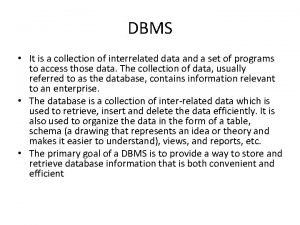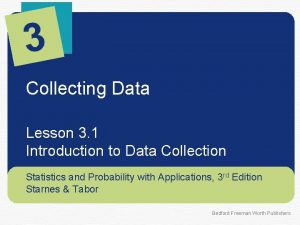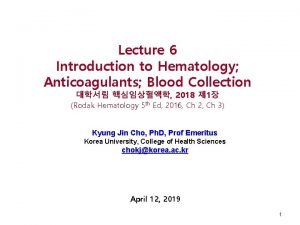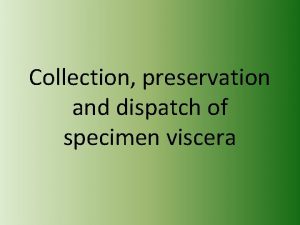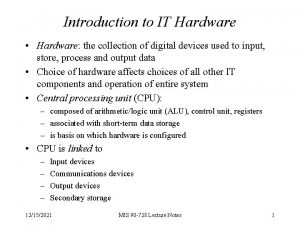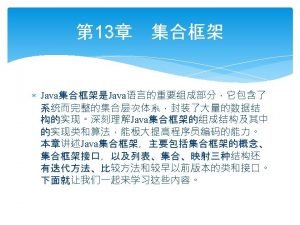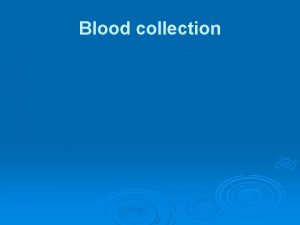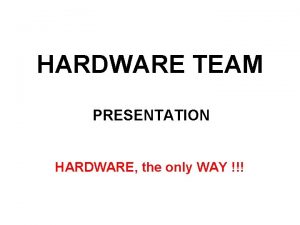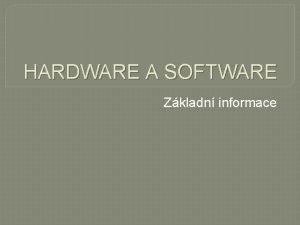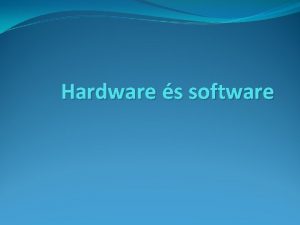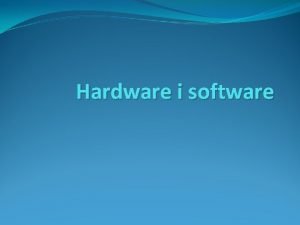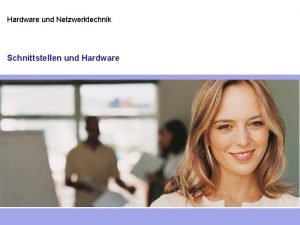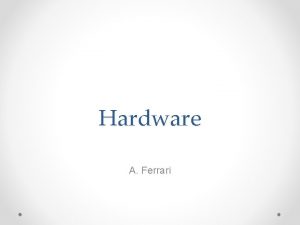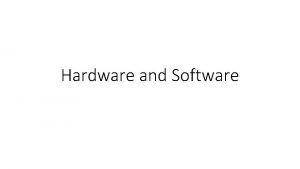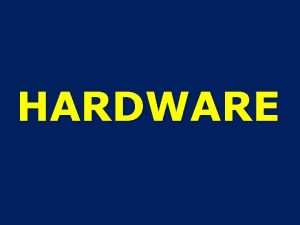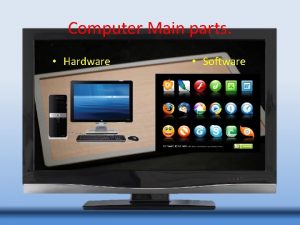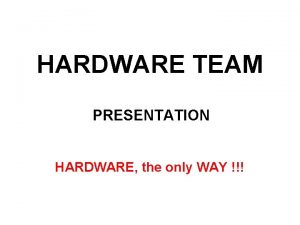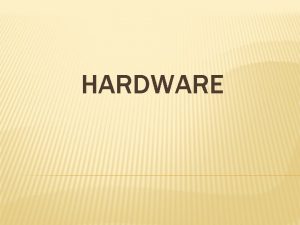Introduction to IT Hardware Hardware the collection of



















- Slides: 19

Introduction to IT Hardware • Hardware: the collection of digital devices used to input, store, process and output data • Choice of hardware affects choices of all other IT components and operation of entire system • Central processing unit (CPU): – composed of arithmetic/logic unit (ALU), control unit, registers – associated with short-term data storage – is basis on which hardware is configured • CPU is linked to – – Input devices Communications devices Output devices Secondary storage 10/29/2020 MIS 90 -728 Lecture Notes 1

Evaluating CPUs and Memory • CPUs are evaluated using the concepts of machine cycle time, clock speed, and wordlength and bus line width • Machine cycle time: – length of time required to execute single instruction – Expressed as microseconds (time) or millions of instructions per second (MIPS; rate) • Clock speed: – rate at which the CPU produces electronic pulses – based on execution of elementary instructions – Expressed as millions of cycles per second (Megaherz; MHz) • Wordlength and bus line width – wordlength is number of bits CPU can process at once – bus line width is amount of bits that can be transferred among components 10/29/2020 MIS 90 -728 Lecture Notes 2

Comparing CPUs • CPU measures of machine cycle time, clock speed and wordlength/bus line width cannot be directly compared • Clock speed along is insufficient for good comparisons • Intel Corporation has introduced Intel Comparitive Microprocessor Performance Index, or i. COMP – i. COMP weights values of various measures – is used for comparing Intel processors, not systems; system performance affects CPU performance • CPU empirical principles – All else equal, more clock speed is preferable to less – CPU speed always increases due to increase in transistor densities (Moore’s Law) 10/29/2020 MIS 90 -728 Lecture Notes 3

Memory Characteristics • Memory associated with CPU measured in thousands, millions, etc. of bytes (KB, MB…) of storage capacity • Memory types: – volatile random access memory (RAM), data that disappears when the system is powered down – non-volatile read-only memory (ROM), providing permanent storage for data and instructions that do not change over time – Cache memory, high-speed memory providing access to frequently used data • Secondary storage represents permanent storage of greater volumes of data than available in main storage: – – – Magnetic tapes Magnetic disks (incl. RAID) Optical disks Digital video disk (DVD) Removable storage 10/29/2020 MIS 90 -728 Lecture Notes 4

Input Devices • Input devices provide data and instructions to the computer. • Management issues associated with input devices include: – is input data human-readable, or machine-readable, or both? – Can data entry and data input be done on-line and instantly? – Can input data be modified? • Types of input devices include: – – – – – keyboard and mouse voice-recognition devices digital computer cameras terminals scanning devices optical data readers magnetic ink character recognition (MICR) devices automatic teller machine (ATM) devices bar code scanners 10/29/2020 MIS 90 -728 Lecture Notes 5

Output Devices • Output devices are intended to provide information to decisionmakers or to other information systems • Types of output devices: – – – cathode-ray tube (CRT) display monitor liquid-crystal display (LCD) display monitors printers and plotters computer output microfilm (COM) devices speakers multifunction devices Choosing the right mix of input and output devices can mean the difference between an IS that is implemented successfully or not 10/29/2020 MIS 90 -728 Lecture Notes 6

Computer Systems • Computer systems are the collection of CPU type, memory, input and output devices • Computer systems can be classified in the following way: 10/29/2020 MIS 90 -728 Lecture Notes 7

Introduction to IT Software • Computer software (programs) provide sequences of instructions to control operations of computer hardware: – Software can comprise 75% or more of the total cost of an IS – Expense of software due to developer salaries, increasingly complex requirements and reductions of hardware costs • Computer software can be divided into two categories: – systems software, which coordinates activities of hardware and various programs. Combination of systems software and hardware configuration is called the computer system platform – application software, which help users solve particular computing problems of importance to individual, group or enterprise. 10/29/2020 MIS 90 -728 Lecture Notes 8

Management Issues in Software Use • One way to classify software is by the portion of the organization affected by use of the software, or sphere of influence – personal: software addresses needs of individual user – workgroup: two or more people who work together to achieve common goal – enterprise: firm or company • Use of software had brought about issues that previously were addressed in an organization-by-organization basis: – software licensing: copyright protection and patent laws – software upgrades: purchase/no purchase decision, distributing changes – software support: outsourcing, free vs. pay, medium by which help delivered 10/29/2020 MIS 90 -728 Lecture Notes 9

Systems Software • Operating systems typically execute a variety or tasks: – – Providing common computer hardware functions Providing a user interface Managing system memory Controlling access to system resources • Operating systems act as a buffer between application programs and computer hardware • Common features of operating systems: – – – graphical user interface hardware independence multitasking/multithreading time-sharing scalability networking capability 10/29/2020 MIS 90 -728 Lecture Notes 10

Popular Operating Systems • MS-DOS – single-user, single-task system – requires specialized knowledge of command syntax – limited memory management • DOS with Windows – actually a shell that sits atop MS-DOS – graphical user interface, some multitasking capabilities – developed in response to Apple Macintosh OS • OS/2 – true multitasking/multithreading capability – significant memory requirements – lack of consumer applications written for OS/2 10/29/2020 MIS 90 -728 Lecture Notes 11

Popular Operating Systems (cont’d) • Windows 95 – – true 32 -bit, multitasking, multithreading OS vulnerable to “misbehaving” 16 -bit applications uses desktop metaphor solidified Microsoft position as pre-eminent supplier of PC OS • Mac OS 8. 1 – Intended to run on Motorola Power. PC processors – dominant in education, publishing and graphic arts – supports novice through expert user with variable user environment • Windows NT 5. 0 – designed to run on multiple hardware platforms – centralized security system – represents strategic direction of all Microsoft OSs 10/29/2020 MIS 90 -728 Lecture Notes 12

Popular Operating Systems (cont’d) • Unix – OS of choice for large database applications and application servers – Arcane, text-based user interface supplanted by Motif/X-Windows GUI – platform independent • What OS is right for your organization? Try to account for: – – – OS market share networking capabilities type of application programs used ease of use OS management requirements • Utility programs are used to enable an OS to run more efficiently and safely: – – anti-virus protection diagnosing hardware problems security management automated data backup 10/29/2020 MIS 90 -728 Lecture Notes 13

Application Software • Application software programs that help individuals, workgroups and organizations become more productive and meet organization goals • Types of application software: Pros Cons – proprietary – off-the-shelf • Personal application software: – – – word processing spreadsheet analysis databases graphics programs on-line information services software suites 10/29/2020 MIS 90 -728 Lecture Notes 14

Workgroup/Enterprise Application Software • Groupware is software that enables persons to work more efficiently together • Types of groupware: – Lotus Notes – Group scheduling/project management • Three C’s of groupware: convenient, content, coverage • Enterprise application software address problems common to a whole organization: – – – accounts receivable general ledger shipping payroll enterprise resource planning 10/29/2020 MIS 90 -728 Lecture Notes 15

Software Development • Programming languages are coding schemes that provide instructions to the computer system to perform a processing activity • Programming languages have evolved over time: – First-generation languages: machine languages – Second-generation languages: assembly language – Third-generation languages: use of symbolic code, hardwareindependent (Cobol, C, Pascal, Basic) – Fourth-generation languages: more visual, less procedural, focus on intended outputs (Access, Visual Basic, SQL) – Object-oriented languages: tie data and procedures into objects, enable reusability and modularity (Smalltalk, C++, Java) – Fifth-generation languages: visual programming, reuse management to enable knowledge-based applications (Java Studio/Java Beans) 10/29/2020 MIS 90 -728 Lecture Notes 16

The Internet • The Internet is a worldwide collection of interconnected networks; estimated 200, 000 networks and 100 million computers • The Internet works by transmitting data from one computer (a host) to another using: – the Internet Protocol (IP) and Transport Control Protocol (TCP) – Uniform Resource Locater (URL) • Host URLs follow this convention: – Foreign hosts end URL with country abbreviation – U. S. hosts end URL with affiliation ID, e. g. . arts, . com, . mil, . org • The Internet can be accessed by: – – LAN server SLIP/PPP On-line service Internet service provider 10/29/2020 MIS 90 -728 Lecture Notes 17

Internet Services • E-mail: send messages to remote users incorporting sound, graphics, hyperlinks as well as plain text • Telnet and FTP: log in to remote computers to transfer files • Usenet and Newsgroups: follow threaded discussions stored on host computers on a variety of subjects • Internet Phone/Videoconferencing: route phone calls and faxes over same network used to transfer data, bypassing phone company • Content streaming: method to transfer multimedia files over the Internet so that voice and pictures are aligned 10/29/2020 MIS 90 -728 Lecture Notes 18

The World Wide Web • Originally conceived as a document management system, has evolved to thousands of Web servers that allow access to specialized documents that store text, data, images and sound • A Web site is a collection of files designed to allow the user access to various files (Web pages) in a predefined order • A Web browser is an application that translates specialized commands (HTML) with which Web pages are created into a graphical interface • Search engines are tools that allow users to quickly scan the internet for Web pages that satisfy certain criteria • Java is a programming language that enables applications residing on a Web page to be run on the user’s computer The Web is revolutionizing many business, non-profit and personal activities by enabling universal connectivity 10/29/2020 MIS 90 -728 Lecture Notes 19
 Landsat collection 1 vs collection 2
Landsat collection 1 vs collection 2 Types of documentary collection
Types of documentary collection What is collection of interrelated data
What is collection of interrelated data External computer hardware
External computer hardware Lesson 3.1 introduction to data collection
Lesson 3.1 introduction to data collection Introduction of blood collection
Introduction of blood collection Preservation of viscera
Preservation of viscera Hình ảnh bộ gõ cơ thể búng tay
Hình ảnh bộ gõ cơ thể búng tay Bổ thể
Bổ thể Tỉ lệ cơ thể trẻ em
Tỉ lệ cơ thể trẻ em Chó sói
Chó sói Thang điểm glasgow
Thang điểm glasgow Hát lên người ơi
Hát lên người ơi Kể tên các môn thể thao
Kể tên các môn thể thao Thế nào là hệ số cao nhất
Thế nào là hệ số cao nhất Các châu lục và đại dương trên thế giới
Các châu lục và đại dương trên thế giới Công thức tính thế năng
Công thức tính thế năng Trời xanh đây là của chúng ta thể thơ
Trời xanh đây là của chúng ta thể thơ Mật thư anh em như thể tay chân
Mật thư anh em như thể tay chân


